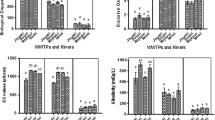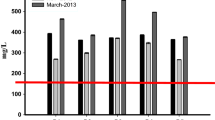Abstract
Machilipatnam, the headquarters of Krishna District, is well known for its rold gold jewellery which has a great demand from different parts of the country. The major problem associated with this industry is the discharge of toxic materials and heavy metals through effluent wastewater. The wastewater is characterized by a strong colour and is heavily polluted with high chemical oxygen demand (COD), biochemical oxygen demand (BOD), inorganic impurities (calcium, sodium, sulphates, phosphates, nitrates, chromium, copper, cyanide, iron and nickel), dissolved and suspended solids. Because this wastewater is hazardous to human health and as well the environment, it is important to manage it safely. Among various remediation techniques, phytoremediation is a green approach and is widely employed for treating polluted water and soil by growing plants. Aquatic plants play major role in the remediation of contaminated water bodies because of their ability to uptake heavy metals and trace elements in large quantities. In the present paper, the effluent wastewater collected from the treatment plant of jewellery park is analysed for various physico-chemical parameters and for the presence of certain heavy metals. The paper also reviews on the ability of different aquatic plants in bioremediating effluent wastewater from electroplating industries with a special focus on Hydrilla verticillata.
Access this chapter
Tax calculation will be finalised at checkout
Purchases are for personal use only
Similar content being viewed by others
References
Ruiz-Martinez A, Martin-Garcia N, Romero I, Seco A, Ferrer J (2012) Microalgae cultivation in wastewater: nutrient removal from anaerobic membrane bioreactor effluent. Bioresour Technol 126:247–253
Waisberg M, Joseph P, Hale B, Beyersmann D (2003) Molecular and cellular mechanisms of cadmium carcinogenesis. Toxicol 192:95–117
Pandey S, Srivastava VS (2002) Heavy metal accumulation in industrial solid waste amended soils. Nature Environ Pollut Technol 1(1):73–75
Kabata-Pendias A (2011) Trace elements in soils and plant. CRC Press, Boca Raton, USA
Uqab B, Mudasir S, Sheikh AQ, Nazir R (2016) Bioremediation: a management tool. J Bioremed Biodeg 7:331
Kamran MA, Mufti R, Mubariz N, Syed JH, Bano A et al (2014) The potential of the flora from different regions of Pakistan in phytoremediation: a review. Environ Sci Pollut Res 21:801–812
Sharma S, Iffat N, Ishtiaq A, Safia A (2011) Monitoring of physico-chemical and microbiological analysis of under ground water samples of district Kallar Syedan, Rawalpindi-Pakistan. Res J Chem Sci 1(8):24–30
Deshpande SM, Aher KR (2012) Evaluation of groundwater quality and its suitability for drinking and agriculture use in parts of Vaijapur, District Aurangabad MS. India Res J Chem Sci 2(1):25–31
Singh DB, Prasad G, Rupainwar DC (1996)Adsorption technique for the treatment of As (V) rich effluents. Colloids Surf III 49–56
Hartman WJ(1975) An evaluation of lead treatment of municipal west water and physical siting of facility installations. US Department of arm, Washington, DC
Jadia DC, Fulekar MH (2009) Phytoremediation of heavy metals: recent techniques. African J Biotechnol 8:921–928
Sarma H (2011) Metal hyperaccumulation in plants: a review focusing on phytoremediation technology. J Env Sci Tech 4:118–138
Abida B, HariKrishna S (2010) Bioaccumulation of trace metals by aquatic plants. Int J Chem Tech Res 2(1):250–254
Abida B, Ramaiah M, Harikrishna S, Khan I, Veena K (2009) Heavy metal pollution and chemical profile of Cauvery River water. J Chem 6(1):47–52
Abida B, Ramaiah M, Harikrishna S, Khan I, Veena K (2009) Analysis of heavy metals concentration in soil and litchens from various localities of Hosur road. J Chem 6(1):13–22
Yaowakhan P, Kruatrachue M, Pokethitiyook P, Soonthornsarathool V (2005) Removal of lead using some aquatic macrophytes. Bull Environ Contam Toxicol 75:723–730
Sutton DL, Ornes WL (1975) Phosphorus removal from static sewage effluent. J Environ Quality 4:367–370
Pratas J, Favas PJC, Paulo C, Rodrigues N, Prasad MNV (2012) Uranium accumulation by aquatic plants from uranium-contaminated water in Central Portugal. Int J Phytoremed 14:221–234
Kinnersely AM (1993) The role of phytochelatins in plant growth and productivity. Plant Growth Regul 12:207–217
Priyanka SP, Shinde O, Sarkar S (2017) Phytoremediation of Industrial mines waste water using Water hyacinth. Int J Phytorem 19(1):87–96
Chaudhary E, Sharma P (2014) Duckweed as ecofriendly tool for phytoremediation. Int J Sci Res (IJSR) 3(6)
Naghipour D, Ashrafi SD, Gholamzadeh M, Taghavi K, Naimi-Joubani M (2018) Phytoremediation of heavy metals (Ni, Cd, Pb) by Azolla filiculoides from aqueous solution: a dataset. Data Brief 21:1409–1414
Sood A, Uniyal PL, Prasanna R, Ahluwalia AS (2012) Phytoremediation potential of aquatic macrophyte, Azolla. AMBIO 41:122–137
Mandakini LLU, Bandara NJGJ, Gunawardana D, A Study on the phytoremediation potential of azolla pinnata under laboratory conditions. Department of Forestry and Environmental Science, University of Sri Jayewardenepura, Sri Lanka, Department of Botany, University of Sri Jayewardenepura, Sri Lanka
Tangahu BV, Sheikh Abdullah SR, Hassan B, Idris M, Anuar N, Mukhlisin M (2011) Review on heavy metals (As, Pb, and Hg) uptake by plants through phytoremediation. Int J Chem Eng Article ID 939161
Chakraborty R, Mitra AK, Mukherjee S (2013) Synergistic chromium bioremediation by water lettuce (Pistia) and Bacteria (Bacillus cereus GXBC-1) Interaction. J Biol Chem Research 30(2)421-431
Reddy CS, Reddy KVR, Humane SK, Damodaram B (2012) Accumulation of chromium in certain plant species growing on mine dump from Byrapur, Karnataka, India. Res J Chem Sci 2(12):17–20
Haller WT, Sutton DL (1975) Community structure and competition between Hydrilla and Vallisneria. Hyacinth Control J 13:48–50
Mahler MJ (1979) Hydrilla, the number one problem. Aquatics 1:56
Rai UN, Tripathi RD, Sinha S, Chandra P (1995) Chromium and Cadmium bioaccumulation and toxicity in Hydrilla verticillata (l.f.) Royle and Chara corallina Wildenow. J Environ Sci Health Part A 30(3):537–551
Patel DK, Kanungo VK (2012) Study on growth, potential utility and N.P.P. of a submerged aquatic plant Hydrilla verticillata Casp. J Exp Sci 3:48–50
Mc Cutcheon CS, Schnoor JL (2004) Phytoremediation: transformation and control of contaminants. Wiley, vol 898. ISBN 978-0-471-45932-3
Abdul A, Aldhamin AS (2016) Phytoremediation of chromium and copper from aqueous solutions using Hydrilla verticillata. Iraqi J Sci 57(1):78–86
Hassan NA, Al-Kubaisi ARA, Al-Obiadi AHM (2016) Phytoremediation of lead by Hydrilla verticellata Lab. Work Int J Curr Microbiol App Sci 5(6):271–278
Phukan P, Phukan R, Phukan SN (2015) Heavy metal uptake capacity of Hydrilla verticillata: a commonly available aquatic plant. Int Res J Environment Sci 4(3):35–40
Kameswaran S, Vatsala TM (2017) Efficacy of bioaccumulation of heavy metals by Aquatic Plant Hydrilla verticillata royle. Int J Sci Res (IJSR) 6(9):535–538
Xue PY, Li GX, Liu WJ, Yan CZ (2010) Copper uptake and translocation in a submerged aquatic plant Hydrilla verticillata (L.f.) Royle. Chemosphere 81(9):1098–103
https://pdfs.semanticscholar.org/f9e6/bfe0fd70ae33b69d88ffa4d44a42c9cc3b0c.pdfn
Acknowledgements
Authors acknowledge the support of Machilipatnam Imitation Jewellery Park Pvt. Ltd. Pothepally, Machilipatnam, Krishna District, Andhra Pradesh, India, for providing us common effluent treatment plant inlet water and for extending their help in the wastewater analysis.
Author information
Authors and Affiliations
Corresponding author
Editor information
Editors and Affiliations
Rights and permissions
Copyright information
© 2021 Springer Nature Singapore Pte Ltd.
About this paper
Cite this paper
Suseela, L., Swarupa Rani, M., Ashok Kumar, K. (2021). Physico-Chemical and Heavy Metal Analysis of Effluent Wastewater from Rold Gold Jewellery Industries and to Review on Its Safe Disposal Using Phytoremediation Approach with Special Emphasis on Hydrilla Verticillata, an Aquatic Plant. In: Kumar, S., Kalamdhad, A., Ghangrekar, M. (eds) Sustainability in Environmental Engineering and Science. Lecture Notes in Civil Engineering, vol 93. Springer, Singapore. https://doi.org/10.1007/978-981-15-6887-9_27
Download citation
DOI: https://doi.org/10.1007/978-981-15-6887-9_27
Published:
Publisher Name: Springer, Singapore
Print ISBN: 978-981-15-6886-2
Online ISBN: 978-981-15-6887-9
eBook Packages: EngineeringEngineering (R0)




